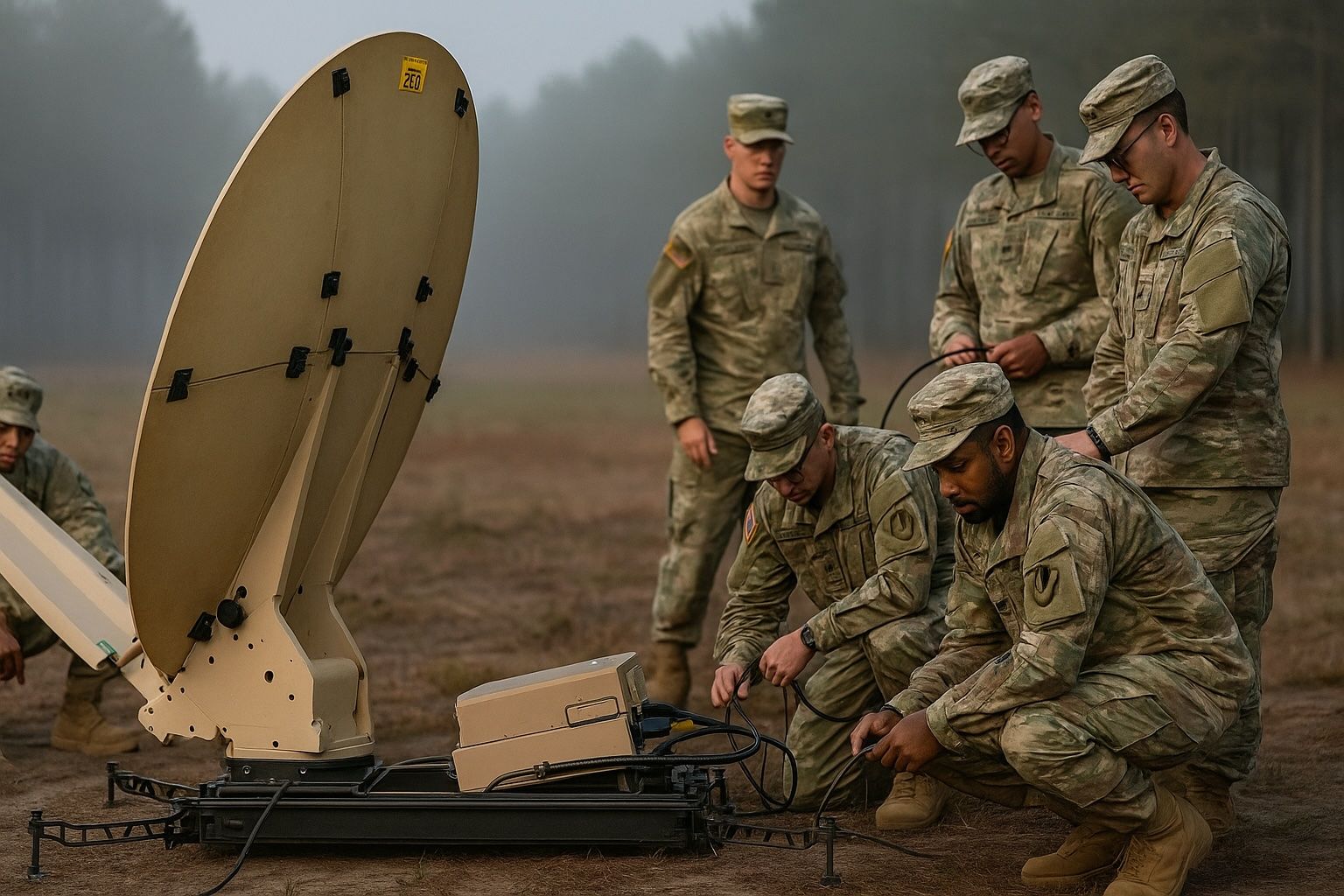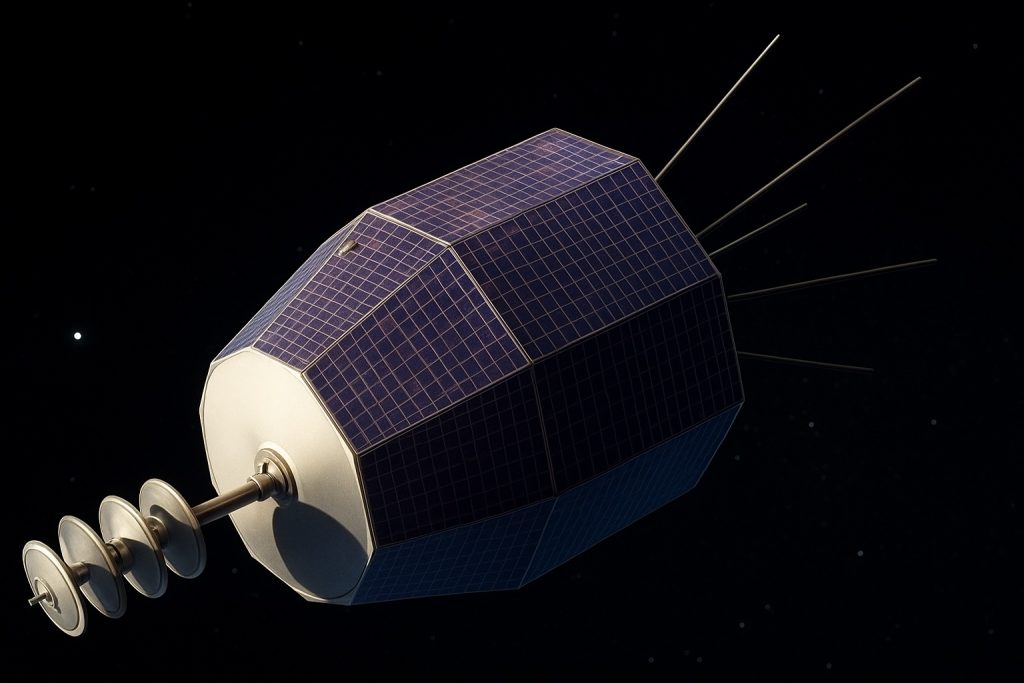- The Pentagon aims to field a software-defined, multi-layer Enterprise SATCOM network that seamlessly routes data across DoD, allied, and commercial satellites in LEO, MEO, and GEO to support Joint All-Domain Command and Control (JADC2).
- In 2020 the Space Force and DoD CIO committed to the shift, with the SDA launching the National Defense Space Architecture (NDSA), later renamed the Proliferated Warfighter Space Architecture (PWSA), to field hundreds of small satellites as a mesh-layer backbone.
- Interoperable Hybrid Terminals would allow a single device to talk to any authorized satellite by software, with the Air Force aiming to field its first multi-network terminal by 2026.
- Ground infrastructure modernization includes the meshONE-T terrestrial data network, for which Space Force awarded Sev1Tech a $188 million contract in September 2024.
- MILNET, disclosed in June 2025, is a 480+-satellite LEO constellation built by SpaceX, government-owned but contractor-operated, reportedly managed by the NRO and linked to Starlink via Starshield terminals.
- SDA’s Tranche 1 comprises 158 satellites (126 transport, 28 tracking, 4 demo) and is slated to be launched with a schedule pushing from Sept 2024 to late summer 2025, with all Tranche-1 sats expected in orbit by early 2027.
- The ESC-MC Implementation Plan released December 2022–January 2023 defines three phases: standards in FY23, data/networks integration in FY24, and automated enterprise capabilities in FY26–29, establishing Space Command as global SATCOM manager and DISA as service provider.
- The March 2025 GAO report recommends annual DoD reporting on Enterprise SATCOM through 2030 and notes the need for outcome-based metrics amid ongoing integration delays.
- The FY2025 Space Force budget is about $29.6 billion, with new funding for proliferated lower-complexity satellites and a large portion of SDA costs, while roughly one-third of Space Force growth since its creation has come from transfers of SDA funding.
- NATO relies on the NATO SATCOM Services – 6th Generation (NSS6G) program, pooling capacity among the US, UK, France, Italy and soon Spain and Luxembourg, as a closely analogous model for an allied, enterprise-scale SATCOM mesh.
Executive Summary: The Pentagon has long sought a “space internet” – an integrated military satellite network that automatically routes data across U.S., allied, and commercial satellites. This enterprise SATCOM vision promises resilience and high-speed connectivity, but it has been dogged by technical, bureaucratic, and industrial challenges. Recent reporting and studies show that legacy hardware, fragmented standards, supply-chain bottlenecks, and inter-service turf fights have slowed progress. With Congress and watchdogs demanding accountability, U.S. space leaders are now scrambling to modernize ground stations, develop software-defined “hybrid” terminals, and finalize contracts (like the secretive MILNET constellation) to break the logjam. This report traces the background, goals, key players, and setbacks in the unified satellite-network initiative; compares it to allied and adversary efforts; and assesses what the struggles mean for future warfare and space strategy.
Background: Toward a “Space Internet”
The idea of a unified military satellite network dates back years. The U.S. defense community realized that current SATCOM is “linear” and siloed – each branch uses different radios and satellites that cannot interconnect on the fly [1] [2]. In practice this means U.S. forces sometimes rely on “bespoke pizza box” terminals – custom hardware racks that link to a single satellite constellation – to talk over space [3]. In a modern war, this hardware-centric model is a liability. By contrast, commercial 5G/Internet systems use unified standards (thanks to 3GPP) so a phone can roam seamlessly. The military wants something similar for satellites: a virtualized, software-driven Enterprise SATCOM network that automatically routes data across DoD, allied, and commercial satellites in LEO, MEO, and GEO [4] [5].
In 2020, the new U.S. Space Force and DoD CIO formally committed to this shift. The space acquisition agency (SDA) launched the National Defense Space Architecture (NDSA) – now renamed the Proliferated Warfighter Space Architecture (PWSA) – to field hundreds of small satellites as a mesh-layer backbone [6]. At the same time, Pentagon leaders championed “Joint All-Domain Command and Control” (JADC2) – an umbrella concept aiming to network sensors and shooters across land, sea, air, cyber and space. In this vision, SATCOM enterprise is the critical backbone of JADC2, so that troops, ships, planes and weapons can all exchange data instantly via resilient satellite links [7] [8].
Despite the vision, implementation lagged. Each service and agency continued building its own systems. Congress and the Government Accountability Office (GAO) have repeatedly warned that without an overarching standard, DoD will remain slow and brittle [9] [10]. In 2023 the DoD Chief Information Officer (CIO) John Sherman issued an Enterprise SATCOM Management and Control (ESC-MC) Implementation Plan, laying out a phased roadmap to develop common standards, governance, and integrated tools [11] [12]. Even so, by mid-2025 Pentagon insiders admit the “space internet” is still a distant goal [13] [14].
Commercial constellations have exploded in LEO in recent years. SpaceX’s Starlink (pictured) and others like OneWeb and Amazon’s Kuiper changed the economics of SATCOM – but each uses proprietary terminals. This is a mixed blessing for the military: Starlink terminals are easy to field and jam-resistant, but they work only with SpaceX’s own satellites [15] [16]. Pentagon planners worry about single-vendor lock-in and thus insist on a multi-vendor, multi-orbit hybrid architecture with built-in redundancy [17] [18]. In short, the U.S. wants the agility of the Internet of Things in space – but with the security to survive a peer adversary’s jamming or anti-satellite attack.
Technical Goals and Architectural Vision
The ultimate goal is a software-defined, multi-layered SATCOM network that seamlessly ties together classified military constellations, allied satellites, and commercial services [19] [20]. Key technical elements include:
- Interoperable “Hybrid Terminals.” New user terminals (modems/radios) should “do it all” via software. Rather than swapping out hardware when switching to a new satellite system, a terminal would download a new waveform and instantly talk to any compatible satlink [21] [22]. All three services are now racing to develop such terminals: for example, the Air Force aims to field its first multi-network terminal by 2026 [23].
- Modernized Ground Infrastructure. Pentagon teleports and ground stations were built for old GEO satellites. A true space internet needs reimagined ground networks to manage data across LEO/MEO/GEO. The DoD plans ground-architecture upgrades (including cloud-based “data transport” networks like meshONE-T [24]) and software systems to give operators a 360° picture of all available links [25] [26].
- Centralized Network Management (ESC-MC). The ESC-MC system (Enterprise SATCOM Management & Control) is envisioned as the “Mission Control” center. It would show users all service, commercial, and allied SATCOM options and autonomously pick the best path [27]. In theory, if one satellite is jammed, ESC-MC would reroute traffic through another constellation. Achieving this demands common standards (a “3GPP moment” for satellites) to allow data sharing and automated resource allocation [28] [29].
These goals are technically feasible – the commercial sector already uses multi-orbit routing – but implementing them across military systems is complex. All the pieces (satellites, terminals, ground, control software) must work in concert, and military SATCOM must meet stringent security, anti-jam, and reliability requirements [30] [31]. For example, while commercial networks can accept dropped packets, the military demands near-100% uptime even under attack, complicating design. Still, officials are clear that hybridization is the end state. “Resiliency comes through greater diversification,” notes a senior Pentagon SATCOM planner [32].
Current practice illustrates the problem. This image (U.S. Army PEO-C3N) shows different branch-specific satellite terminal kits. Today, an Army unit might use one set of hardware to talk to government MILSTAR/GEO sats, then use a completely different “pizza box” to tap SpaceX Starlink or OneWeb. Under the hybrid vision, these should collapse into one device (or network node) that talks to any authorized satellite via software. To bridge the gap, DoD is funding new ground-switching servers and virtualization. In the meantime, each service is accelerating procurements of more agile satellite modems and deploying mixed commercial/leverage links on platforms – steps toward the eventual mesh.
Agencies and Stakeholders
Implementing a unified SATCOM enterprise spans the entire U.S. space bureaucracy. Key players include:
- DoD CIO: The Department’s Chief Information Officer (recently Katie Arrington) is driving the ESC-MC program and broader SATCOM standards. The CIO office released the ESC-MC Implementation Plan (Dec 2022) and will oversee annual progress reporting (per GAO’s recommendation [33]).
- U.S. Space Force: Within DoD, the Space Force (especially Space Systems Command and U.S. Space Command) has prime operational roles. By policy, U.S. Space Command is designated the “Global SATCOM Manager” – the lead unified operator of military SATCOM [34]. The Space Force provides Space Command’s satellites and also leads force design and experimentation for future architectures. For example, Space Force Delta 8 (Schriever SFC) is specifically focused on SATCOM and has begun integrating new constellations like MILNET [35].
- Space Development Agency (SDA): Now a Space Force component since 2023, SDA is mandated to quickly field proliferated LEO sats as a joint “transport layer” for JADC2. Its PWSA constellations (Tranche 1 and beyond) are intended to form the mesh backbone [36] [37]. SDA operates under a “spiral development” model of frequent launches.
- Defense Information Systems Agency (DISA): Handles terrestrial communications infrastructure and integration with DoD networks. DISA will help connect SATCOM to the Global Information Grid and interoperability domains.
- Allied partners / NATO: The unified network vision explicitly includes foreign satellites. NATO already uses a sharing scheme (NSS6G) where U.S., UK, France, Italy (soon Spain, Luxembourg) pool military SATCOM resources for NATO operations [38] [39]. In future, allied constellations (e.g. UK’s Skynet, France’s Syracuse, Italy’s Sicral, Luxembourg’s GovSat) may be treated as additional “nodes” on the enterprise network.
- Congress and GAO: Lawmakers and watchdog agencies have scrutinized DoD’s SATCOM plans. Recent mandates (in Senate reports and NDAAs) require annual progress reports and GAO reviews on “Enterprise SATCOM” and hybrid architectures [40]. This oversight aims to force better coordination and transparency.
Each stakeholder has its own priorities: Services want systems tailored to their missions, the Space Force wants joint architectures, and Congress demands accountability. Internal coordination has historically been weak – different branches used different procurement timelines and requirements. The DoD CIO and Space Force are now trying to impose top-down guidance, but breaking stovepipes is still a work in progress [41] [42].
Role of Commercial Contractors
Commercial space companies are integral to the strategy, both as satellite providers and technology partners. Leading contractors include:
- SpaceX: A key SATCOM partner. Its Starlink constellation is already used by U.S. forces (and Ukraine) for high-speed data. In 2025 DoD secretly contracted SpaceX to build MILNET – a 480+ satellite LEO constellation (government-owned but contractor-operated) that will become part of the Defense Department’s future hybrid mesh [43]. MILNET will use upgraded “Starshield” military terminals (with enhanced encryption) to interoperate with SpaceX’s commercial network [44]. SpaceX also won a share of the $13 billion Proliferated LEO Satellite-Based Services (POWERS) IDIQ to provide Starshield/Starlink access to U.S. forces.
- Northrop Grumman: One of SDA’s Tranche 1 prime contractors. Northrop built tracking-layer satellites for PWSA and designed space vehicles for missile warning. A Northrop satellite is pictured ready for launch in defense releases [45].
- Lockheed Martin: Prime integrator for parts of PWSA. Lockheed is supplying 16 wide-FOV missile warning/tracking satellites (Tranche 1) and leading the transport-layer constellation with L3Harris and York Space [46]. Lockheed is also a major SATCOM systems integrator (e.g. Syracuse program in Europe).
- L3Harris: Awarded multiple contracts for PWSA. L3Harris builds communications satellites and secure modems. They are the prime for some of the PWSA transport/communications layer.
- York Space Systems: A commercial small-sat maker tapped as a PWSA prime for transport-layer satellites.
- Hughes Network Systems (EchoStar/Dynetics): A leading satellite-ground equipment provider. Hughes sells GEO/MEO sat modems (often for military/regional use). Its VP, Rajeev Gopal, noted that today you cannot swap modems from OneWeb to Kuiper, highlighting the lack of interoperability [47]. Hughes is actively working on standards and has proposed common modem architectures to address that problem.
- Other Contractors: The overall SATCOM ecosystem also involves Boeing (protected SATCOM prototype), Viasat, SES/Airbus (commercial constellations), and newcomers (e.g. Amazon’s Kuiper constellation, though its military role is still emerging). Prime integrators like BAE Systems and Raytheon contribute to terminals and ground tech (e.g. Protected Tactical SATCOM).
In practice, commercial and defense suppliers must coordinate. SDA hired “mission integrators” (prime contractors like Northrop) to manage constellations across vendors. The Space Force’s Space Systems Command awards diverse contracts (e.g. the $188M Sev1Tech ground-network contract [48]). But with dozens of companies involved, building a common system is challenging. Each contractor designs proprietary hardware and software, so DoD is pushing industry consortia and standards bodies to agree on interfaces – a slow process.
Recent Developments, Contracts, and Policy (2024–2025)
- ESC-MC & Enterprise SATCOM Plan (2022–2023): In December 2022 the DoD CIO released the Enterprise SATCOM Management and Control Implementation Plan, and DoD publicly detailed it in Jan 2023 [49]. This blueprint set a 3-phase schedule: establish standards (FY23), integrate data/networks (FY24), and deliver automated enterprise capabilities (FY26–29) [50]. It cemented U.S. Space Command as the global SATCOM operator and DISA as service provider [51].
- GAO Reports & Oversight: In March 2025 GAO issued a report on DoD SATCOM, recommending annual progress reports to Congress [52]. GAO noted that while DoD has begun integrating systems and automating resource allocation, it still lacks comprehensive outcome-based reporting [53] [54]. The Senate has included provisions in defense legislation mandating such annual reporting through 2030.
- Space Development Agency (PWSA) Launches: SDA’s low-Earth-orbit constellations have faced repeated delays. Tranche 1 (158 satellites: 126 transport, 28 tracking, 4 demo) was to begin launching in Sept 2024, but was pushed to spring 2025 and now to late summer 2025 due to supply-chain bottlenecks [55] [56]. SDA announced it will then launch roughly one batch per month to orbit all Tranche-1 sats by early 2027 [57] [58]. Primes on PWSA Tranche 1 include Lockheed, Northrop, York and L3Harris [59]. In September 2024 Congress also directed SDA to name its program officially as PWSA (replacing “NDSA”) [60].
- MILNET & SpaceX (June 2025): Breaking Defense revealed in June 2025 that the Space Force is paying SpaceX to build MILNET – a confidential new satellite network [61]. Reportedly managed by the NRO, MILNET will be a 480+ satellite mesh in LEO operated by SpaceX with DoD oversight [62]. It will use SpaceX’s Starshield (military-grade) terminals and link to the Starlink constellation. Officials say this is the first-ever government-owned, contractor-operated SATCOM constellation, and it will be folded into the Pentagon’s “hybrid mesh” architecture [63] [64].
- Ground and Data Networks: In Sept 2024 the Space Force awarded a $188 million follow-on contract to Sev1Tech to build out meshONE-T, a terrestrial data network [65]. This ground mesh (now scaling to 85 sites globally) acts as a “data-transport-as-a-service” for DoD, connecting bases and nodes much like a fiber network [66] [67]. Significantly, Space Force said meshONE-T will link to satellite networks to form an integrated data layer [68] – an important step toward the overall space-earth data grid.
- Policy & Congressional Actions: Congress has steadily increased oversight. The 2023 and 2024 NDAAs included language directing DOD to define and integrate its SATCOM plans. A bipartisan “Golden Dome” caucus (focusing on missile defense/space) was formed in mid-2025, though its impact on SATCOM policy is still unclear. Meanwhile, Space Force budget documents for FY2025 show significant investments in “proliferated constellations” and note a new line item for more lower-complexity satcoms [69]. The FY2025 Space Force request ($29.6 billion) added funding for GPS, missile warning, and starts some SDA costs [70] [71]. Overall, appropriators have signaled support for a diversified SATCOM approach and pushed Space Force/Space Development Agency to demonstrate results in orbit.
Current Challenges and Coordination Issues
Multiple obstacles stand between the Pentagon and its unified SATCOM vision:
- Legacy Hardware and Standards: DoD satellites and terminals were bought piecemeal over decades, each built for one frequency and partner. Modernizing them is painfully slow. As GAO notes, the historically decade-long procurement timelines mean new hybrid terminals or gateways risk arriving too late [72]. In the interim, soldiers still juggle incompatible “pizza boxes” [73]. Without an immediate replacement, the military must maintain burdensome hardware or rely on point solutions.
- Lack of Common Standards: Unlike cell networks, SATCOM has no unified protocol. Each commercial constellation (Starlink, OneWeb, Kuiper, SES) uses its own modem. Pentagon planners hope the industry can create DoD-wide standards, but so far companies guard proprietary tech. Hughes VP Gopal bluntly observed: “Can I take a OneWeb modem and replace it with an Amazon Kuiper modem? I do not think that can be done today.” [74]. This vendor fragmentation means ESC-MC must include not just DoD agencies but dozens of industry players, complicating progress [75].
- Institutional Coordination: Within DoD, dozens of offices touch SATCOM: each service, the Joint Staff, NRO, DISA, NGA, etc. Bureaucratic infighting and unclear leadership have slowed enterprise integration. For years the military allowed services to pick their own systems. Now the CIO and Space Force must overcome inertia. For example, when Pentagon CIOs changed in 2024–25 (John Sherman out, Katie Arrington in), space and cybersecurity priorities shuffled, sowing confusion [76]. Analysts warn that better enterprise governance (via ESC-MC and U.S. Space Command) is needed to break these stovepipes.
- Supply-Chain and Industrial Issues: The SDA delays highlight industrial strain. That program needs hundreds of satellites. Parts like optical laser terminals, encryption modules, or propulsion systems have experienced shortages [77]. Firms like Boeing and private suppliers can’t instantly scale from dozens to hundreds of units. Similarly, building thousands of ground nodes (or user terminals) to match is a huge task. These bottlenecks drove SDA to acquire Tranche 3 a year early, hoping more lead time eases future production slowdowns [78].
- Avoiding Vendor Lock-In: The Pentagon is wary of relying on a single commercial provider (especially after a spat in 2022 when the White House threatened to cancel SpaceX launch deals over political comments). This caution slows deals; any contract (e.g. for MILNET/Starshield) requires NRO involvement to share risks. Balancing open competition with the need to incorporate Starlink’s leading edge is a constant tension.
In sum, technical solutions exist, but the doctrinal and managerial shifts have lagged. DoD observers note that “we always forget the ground” [79] – meaning that satellite networks are only as good as the terrestrial architecture, data links, and command processes behind them. Getting all players pulling in the same direction remains the big hurdle.
Strategic Implications for National Security
A resilient, unified SATCOM network is now seen as a national-security imperative. In any future great-power war, space links will be targeted by jamming, lasers, or anti-satellite weapons. A hybrid network could allow military units to switch to alternate constellations if one is knocked out, ensuring soldiers don’t lose C2/data during a crisis [80] [81]. Conversely, failing to build the network leaves the U.S. vulnerable. As an Army communications chief warned, in a fast-moving fight “hardware is a liability; software upgrades are a lot faster” [82].
Battlefield connectivity is central to JADC2 and future “kill chains.” Every fighter jet, missile, or drone depends on high-data-rate links for targeting and coordination. The satellite enterprise (together with 5G, fiber, etc.) forms the backbone of those links. Industry experts argue that without interoperable SATCOM, the U.S. loses the game of sensor-fusion and multi-domain ops against China or Russia. China’s military thinkers are keenly aware of this: recent PLA writings explicitly call for a large LEO constellation to rival Starlink, to “suppress” U.S. networks [83]. Russia, meanwhile, is rebuilding its own Integrated Satellite Communication System (ESSS) using GEO and elliptical orbits [84]. The U.S. must thus accelerate or risk ceding space superiority.
More broadly, the SATCOM enterprise intersects with nuclear command and control, missile defense (e.g. providing global missile warning via PWSA), and civilian infrastructure resilience. For instance, a more flexible SATCOM can keep nuclear command lines open even if terrestrial lines fail. On the flip side, every launch or big constellation invites scrutiny – adversaries ask whether a military SATCOM network also means new “staring” sensors or anti-satellite weapons. The Pentagon emphasizes defensive intent, but expert observers caution that large constellations can have dual uses (e.g. intelligence and communications in one).
Budgetary and Legislative Context
Building this network is expensive. Recent budget documents and hearings show sustained (though not unlimited) funding:
- Space Force Budget: FY2025 saw ~$29.6B for Space Force, with an emphasis on proliferated LEO and resilient architectures [85]. Key increases were in GPS ($260M more for GPS III), space-based sensors, and adding PWSA costs. Notably, the FY2025 submission created a new line item for “proliferated sets of lower-complexity satellites” [86]. Program analysts note that much of Space Force’s growth (~1/3) since its creation has come from transfers of spending (including SDA) from other services [87].
- Service Budgets: Other services also invest heavily. FY2025 included $400M+ for Army SATCOM procurement, $200M+ for Navy SATCOM and terminals, and $300M (DARPA/MDA space R&D) [88]. These reflect purchases of commercial terminals, mil-sat builder ships, and R&D for next-gen links (e.g. airborne satcom, anti-jam tech).
- Congressional Mandates: The 2023 NDAA required DoD to develop a unified SATCOM strategy and report yearly on progress. Committees have ordered briefings on the MCA (Space Networks Architecture) and oversight on SDA’s acquisition. As mentioned, GAO was directed (in a Senate report) to review DoD SATCOM efforts, resulting in the Mar 2025 report [89]. The House Armed Services emerging threats subcommittee has held hearings questioning why enterprise SATCOM is behind schedule.
- Golden Dome & Spectrum: Though not SATCOM-specific, a new Trump administration initiative (“Golden Dome” missile defense) underscores congressional appetite for space projects. Additionally, spectrum fights in Congress (e.g. defense of military 5G and SATCOM bands in reconciliation bills) reflect the political importance of preserving future satcom capacity.
Budget pressures cut both ways. On one hand, the era of “big expensive satellites” is waning. The FY2025 strategy pivoted toward smaller, cheaper, more numerous sats [90]. On the other hand, DoD still wrestles with procurement inefficiencies that inflate costs (GAO found average 10-year acquisition schedules [91]). Congress expects tangible outcomes (satellites in orbit, fielded terminals) or else pressures to reallocate funds. The SDA launch delays may invite scrutiny in upcoming appropriations, as planners race to meet on-orbit commitments by 2027 [92].
Timeline of Milestones and Delays
- 2019–2020: U.S. Space Force and DoD declare intent to integrate SATCOM (Chief of Space Ops and DoD Modernization Strategy).
- Dec 2022: DoD CIO John Sherman finalizes ESC-MC Implementation Plan (unreleased) [93].
- Jan 2023: ESC-MC plan publicly released [94], outlining a multi-year roadmap; Pentagon unveils SATCOM enterprise strategy [95].
- 2023–2024: SDA qualifies PWSA Tranche 0 (demonstration sats) and begins assembly of Tranche 1; GAO reviews enterprise SATCOM (mid-2024).
- Sept 2024: Space Force awards $188M Sev1Tech contract for meshONE-T ground network [96]. SSTC (Space Systems Command) begins testbed launches for space data network (EST laser terminals).
- Dec 2024: Space Force releases FY2025 budget emphasizing proliferated LEO satellites; Congress transfers SDA into Space Force.
- Mar 2025: GAO report published, recommending annual DoD reporting on Enterprise SATCOM [97].
- Spring 2025: SDA announces Tranche-1 launch delay to late summer 2025 due to supply chain issues [98]. Efforts to accelerate Tranche 3 acquisition begin.
- Jun 18, 2025: Breaking Defense breaks news of MILNET contract with SpaceX [99].
- Jun 20, 2025: SpaceNews reports Pentagon is “still a long way off” from a unified satellite network [100] [101].
This timeline highlights that while strategic guidance has been in place for years, execution has encountered repeated slips (notably SDA’s launch schedule and terminal development). GAO and Congress now mark 2025–2026 as critical period for deliverables (first tranche launches, terminal fieldings) to justify the new approach.
Commentary from Industry and Experts
Experts and insiders provide frank assessments:
- Military Officials: Pentagon space and comm chiefs emphasize diversification. Col. Jeff Weisler (USSF Delta 8) stressed that “we’ve never had a DoD hybrid mesh network at LEO” and touted MILNET as a “game-changer” for warfighting connectivity [102] [103]. Air Force Gen. Mike Dean, Director of C3I, admits “the way we need to get resiliency is through greater diversification,” implicitly endorsing the hybrid model [104].
- Defense Industry: Contractors acknowledge progress but note gaps. Hughes’ Gopal says interoperability is improving, though civilian 5G-style standardization is still “a much larger industry” away [105]. Raytheon and others have pitched advanced anti-jam terminals (PTS-P, Protected SATCOM) to fill niches in the future enterprise. Lockheed’s SDA leaders highlight speed and agility as their focus: despite schedule slips, SDA officials emphasize that PWSA is delivering “higher degree of operational confidence” through extensive testing [106].
- Analysts and Watchdogs: GAO has repeatedly warned of procurement delays and lack of visibility. A recent GAO blog (“The Space Race: How Can DoD Keep Pace in a Crowded Sky?”) underscores that the $500B commercial SATCOM market is evolving faster than DoD’s contracting pace [107]. Frank Rose (former NNSA deputy) and other voices urge clear interoperability standards and caution that too-aggressive reliance on launch or budget gimmicks (like “back-dooring” SpaceX via NRO) can backfire. In June 2025, Frank A. Rose outlined steps to ensure high-level accountability for joint space programs (the “Golden Dome” op-ed) – implicitly suggesting Congress needs stricter oversight if space integration is to succeed [108].
On balance, insiders believe the enterprise vision is sound but will require cultural changes. RAND analysts note adversaries are watching: China’s concept of “Multi-Domain Precision Warfare” includes its own satcom mesh ambitions, and PLA analysts explicitly advise countermeasures (including building China’s own Starlink-like system) [109]. U.S. experts warn that failing to achieve a resilient SATCOM architecture in the next few years will give China a strategic edge in space-based C2.
International Comparisons
NATO/Allies: NATO has no satellites of its own since 2005; instead it relies on allies’ military constellations under the NATO SATCOM Services – 6th Generation (NSS6G) program [110]. The U.S., UK, France, Italy (soon Spain/Luxembourg) pool SHF/EHF satcom capacity for NATO HQ use [111] [112]. This multinational sharing model is the closest analogue to the U.S. enterprise idea, though in practice it’s heavily managed (capacity allocations and commitments) rather than an automatic mesh. Europe is also pursuing new military SATCOM (e.g. Eutelsat-AB and Iridium-based systems) to reduce dependence on U.S. systems. These will likely plug into NATO as additional nodes, reinforcing allied resilience.
China: China is rapidly expanding its space capabilities. Besides a robust satellite navigation constellation (BeiDou), China’s PLA has numerous comsat programs. A 2025 RAND report notes Chinese doctrinal emphasis on “informatised warfare” where networks dominate. Notably, Chinese military analysts published papers urging the PLA to build a “large-scale constellation similar to Starlink” to directly compete with U.S. mesh networks [113]. In practice, China’s space cadre calls for both extensive commsat constellations and offensive countermeasures (lasers, jammers) against U.S. satellites. China’s first experimental on-orbit refueling test (June 2025) indicates they plan long-endurance sat networks, which could include LEO relays to enhance global reach (and potential dual-use for weapons).
Russia: Russia’s space forces are rebuilding after the Soviet collapse. They maintain an Integrated Satellite Communication System (ESSS) using Meridian (highly elliptical orbits) and Raduga (GEO) satellites for messaging [114]. They also have Garpun (GEO data relay) and Blagovest sat fleets. Their LEO sats (Rodnik/Strela) are limited store-and-forward radios, so they lack a continuous high-throughput mesh network. In recent years Russia announced ESSS-3, a next-gen integrated SATCOM constellation (likely in development) [115]. However, economic and supply constraints (and Ukraine war effects) have slowed Russia’s pace; they are currently more focused on anti-satellite and electronic warfare tools (like jammers) than new large constellations. Still, any Chinese or Russian advances in SATCOM can bolster our adversaries and threaten U.S. forces, giving greater urgency to U.S. efforts.
Outlook and Recommendations
A truly unified satellite network would transform U.S. military communications. To get there, DoD should:
- Enforce Standards and Reporting: GAO’s recommendation is key: DoD must produce annual, outcome-oriented reports on Enterprise SATCOM progress [116]. This will force services to explain delays and focus on results. Congress should follow up to ensure these reports are public and to quantify interoperability gains (e.g. percentage of terminals that can access multiple networks).
- Promote Common Platforms: Wherever possible, avoid service-specific hardware. The Army, Navy, and Air Force should coordinate procurement of hybrid terminals. Joint requirements boards might mandate open APIs or certification for modems. Contract solicitations (like for PWSA and Protected SATCOM) should score interoperability criteria, pressuring industry to collaborate on standards.
- Invest in Ground/Air Complementarity: While satellites get headlines, upgrading the ground backbone is equally critical. Mesh networks like meshONE-T and distributed teleports must be expanded. Integration points (like gateways connecting the Internet Protocol layer across LEO/MEO/GEO) deserve more funding and agile prototyping. Tests and wargames (like agile exercises with JADC2 partners) should stress-test the enterprise concept.
- Diversify the Industrial Base: The Pentagon should balance large primes with smaller innovators. For example, continued support for flexible sat constellations (SDA, plus potential commercial “tactical” sats) ensures the U.S. is not reliant on one architecture. The MILNET/SpaceX model is one approach; the DoD should ensure that other vendors also have paths into the enterprise (e.g. via the POWERS contract pool).
- Monitor Adversary Moves: Keep a close eye on China’s constellations (e.g. Guowang military net) and Russia’s developments. If China deploys Starlink-like LEO sats, the U.S. may need counter-deployments or new resilience measures (such as ground/air relays). Diplomatic and international rules efforts (e.g. at the UN “First Committee”) should continue to address security norms in space, but the primary focus must remain technical adaptability.
Conclusion: The vision of a Pentagon “space internet” – an interconnected satellite network that works seamlessly like terrestrial internet – remains compelling but elusive. As Sandra Erwin of SpaceNews notes, today’s reality is “an ecosystem full of manual processes, hardware silos and incompatible standards” [117]. DoD now has coherent plans and enormous commercial opportunities, but also a stern deadline: adversaries are moving fast, and space is becoming congested. Success will require sustained executive attention, adequate budgets, and industry cooperation. In the end, ensuring the joint force can roam freely across space and cyber domains may prove as pivotal as any weapon system on the battlefield.
Sources: Recent reporting and official documents on the Pentagon’s Enterprise SATCOM efforts [118] [119] [120] [121] [122], congressional news releases [123] [124], and defense analysis [125] [126] have been used to compile this report.
References
1. www.gao.gov, 2. spacenews.com, 3. spacenews.com, 4. spacenews.com, 5. spacenews.com, 6. www.sda.mil, 7. defensescoop.com, 8. defensescoop.com, 9. www.gao.gov, 10. spacenews.com, 11. www.c4isrnet.com, 12. defensescoop.com, 13. spacenews.com, 14. spacenews.com, 15. spacenews.com, 16. www.rand.org, 17. spacenews.com, 18. www.gao.gov, 19. spacenews.com, 20. www.gao.gov, 21. spacenews.com, 22. spacenews.com, 23. spacenews.com, 24. defensescoop.com, 25. spacenews.com, 26. defensescoop.com, 27. spacenews.com, 28. spacenews.com, 29. www.gao.gov, 30. spacenews.com, 31. www.chathamhouse.org, 32. spacenews.com, 33. www.gao.gov, 34. www.c4isrnet.com, 35. breakingdefense.com, 36. defensescoop.com, 37. csps.aerospace.org, 38. www.defense.gov, 39. www.defense.gov, 40. www.gao.gov, 41. www.thestack.technology, 42. www.c4isrnet.com, 43. breakingdefense.com, 44. breakingdefense.com, 45. defensescoop.com, 46. defensescoop.com, 47. spacenews.com, 48. defensescoop.com, 49. www.c4isrnet.com, 50. www.c4isrnet.com, 51. www.c4isrnet.com, 52. www.gao.gov, 53. www.gao.gov, 54. www.gao.gov, 55. defensescoop.com, 56. defensescoop.com, 57. defensescoop.com, 58. defensescoop.com, 59. defensescoop.com, 60. www.sda.mil, 61. breakingdefense.com, 62. breakingdefense.com, 63. breakingdefense.com, 64. breakingdefense.com, 65. defensescoop.com, 66. defensescoop.com, 67. defensescoop.com, 68. defensescoop.com, 69. csps.aerospace.org, 70. csps.aerospace.org, 71. csps.aerospace.org, 72. www.gao.gov, 73. spacenews.com, 74. spacenews.com, 75. spacenews.com, 76. www.thestack.technology, 77. defensescoop.com, 78. defensescoop.com, 79. spacenews.com, 80. spacenews.com, 81. www.gao.gov, 82. spacenews.com, 83. www.rand.org, 84. www.chathamhouse.org, 85. csps.aerospace.org, 86. csps.aerospace.org, 87. csps.aerospace.org, 88. csps.aerospace.org, 89. www.gao.gov, 90. csps.aerospace.org, 91. www.gao.gov, 92. defensescoop.com, 93. defensescoop.com, 94. defensescoop.com, 95. www.c4isrnet.com, 96. defensescoop.com, 97. www.gao.gov, 98. defensescoop.com, 99. breakingdefense.com, 100. spacenews.com, 101. spacenews.com, 102. breakingdefense.com, 103. breakingdefense.com, 104. spacenews.com, 105. spacenews.com, 106. defensescoop.com, 107. www.gao.gov, 108. breakingdefense.com, 109. www.rand.org, 110. www.defense.gov, 111. www.defense.gov, 112. www.defense.gov, 113. www.rand.org, 114. www.chathamhouse.org, 115. www.chathamhouse.org, 116. www.gao.gov, 117. spacenews.com, 118. spacenews.com, 119. spacenews.com, 120. www.gao.gov, 121. defensescoop.com, 122. breakingdefense.com, 123. www.defense.gov, 124. csps.aerospace.org, 125. defensescoop.com, 126. www.c4isrnet.com










